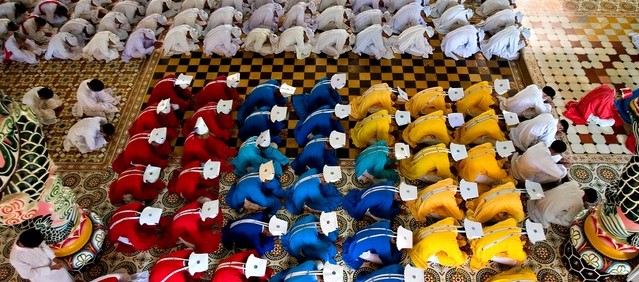
Tay Ninh is situated
95 km north-west of Ho Chi Minh City
and is the original home of the Cao Dai religious sect. It is from here that
Cao Daism has spread its influence onto surrounding provinces. In the years
gone by, this sect had its own army and they were ruthlessly oppressed by the
Diem regime. The Cao Dais did not support the Viet Cong and as a result, following
Reunification, they were punished for this intransigence by the confiscation of
their lands and temples which were not returned to them until 1985.
The central temple,
the Cao Dai
Temple, is located 4 km from Tay Ninh
in the village of
Long Hoa. Surrounded by a
series of schools and administrative buildings, the temple contains an awesome
array of colors and symbols unlike anything else you will see in Vietnam. Built
entirely with donations from its parishioners, the temple is built has nine
levels and the inside is lined with a series of pillars with ornate colored
dragons curling upwards around the pillars. The ceiling of the temple is
painted sky blue and adorned with white fluffy clouds as they represent the
heavens or sky above. In fact, almost everything in the temple has some
symbolic value. At the far end of the great hallway is a large brightly colored
globe upon which is a large eye.
This is the divine "all seeing eye"
believed to represent the creator of the universe and similar eyes can be seen
lining both sides of the building within its lattice windows. The temple always
looks like it has just had a fresh coat of paint and is an extremely great
place to take pictures.
Masses are held at 6
am, midday, 6 PM and midnight. It is worth timing your visit to the temple for
one of these ceremonies as they are quite spectacular. Men enter from and pray
on the right side of the temple whereas women enter from and pray on the left
side.
During festivals, all of the worshipers are dressed from head to toe in
white to add a bit of formality to the scene. The three colors you will see are
red, yellow and blue which represent Confucianism, Buddhism and Taoism
respectively.
If a funeral is in progress, an icon is placed on the central
altar for each of the deceased. Although you are not allowed in the actual area
of worship during prayer, you are allowed in the foyer from where you can take
some great photos of the mass. The Cao Dai do not mind having their photo
taken, though it is always polite to ask first.